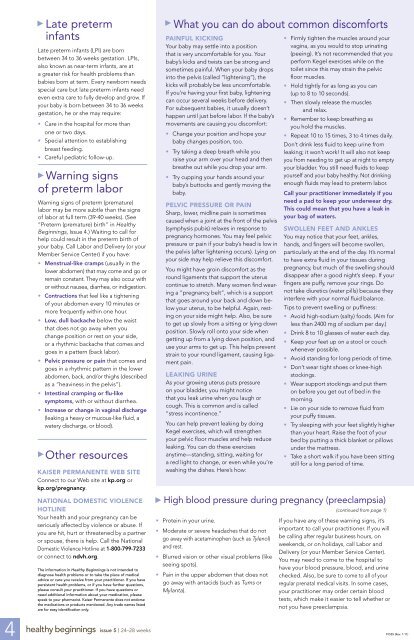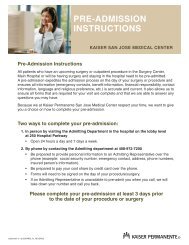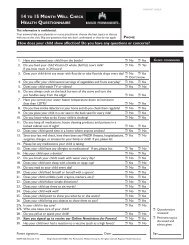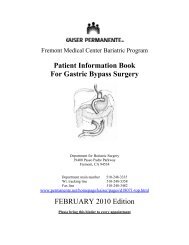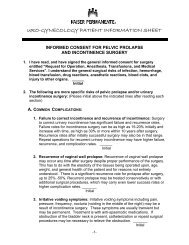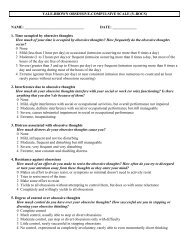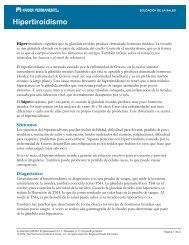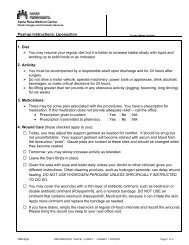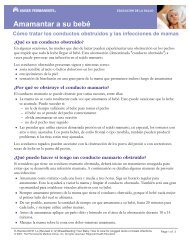24 to 28 weeks (PDF) - Kaiser Permanente
24 to 28 weeks (PDF) - Kaiser Permanente
24 to 28 weeks (PDF) - Kaiser Permanente
Create successful ePaper yourself
Turn your PDF publications into a flip-book with our unique Google optimized e-Paper software.
4<br />
▲ ▲<br />
▲<br />
Late preterm<br />
infants<br />
Late preterm infants (LPI) are born<br />
between 34 <strong>to</strong> 36 <strong>weeks</strong> gestation. LPIs,<br />
also known as near-term infants, are at<br />
a greater risk for health problems than<br />
babies born at term. Every newborn needs<br />
special care but late preterm infants need<br />
even extra care <strong>to</strong> fully develop and grow. If<br />
your baby is born between 34 <strong>to</strong> 36 <strong>weeks</strong><br />
gestation, he or she may require:<br />
• Care in the hospital for more than<br />
one or two days.<br />
• Special attention <strong>to</strong> establishing<br />
breast feeding.<br />
• Careful pediatric follow-up.<br />
Warning signs<br />
of preterm labor<br />
Warning signs of preterm (premature)<br />
labor may be more subtle than the signs<br />
of labor at full term (39-40 <strong>weeks</strong>). (See<br />
“Preterm (premature) birth” in Healthy<br />
Beginnings, Issue 4.) Waiting <strong>to</strong> call for<br />
help could result in the preterm birth of<br />
your baby. Call Labor and Delivery (or your<br />
Member Service Center) if you have:<br />
• Menstrual-like cramps (usually in the<br />
lower abdomen) that may come and go or<br />
remain constant. They may also occur with<br />
or without nausea, diarrhea, or indigestion.<br />
• Contractions that feel like a tightening<br />
of your abdomen every 10 minutes or<br />
more frequently within one hour.<br />
• Low, dull backache below the waist<br />
that does not go away when you<br />
change position or rest on your side,<br />
or a rhythmic backache that comes and<br />
goes in a pattern (back labor).<br />
• Pelvic pressure or pain that comes and<br />
goes in a rhythmic pattern in the lower<br />
abdomen, back, and/or thighs (described<br />
as a “heaviness in the pelvis”).<br />
• Intestinal cramping or flu-like<br />
symp<strong>to</strong>ms, with or without diarrhea.<br />
• Increase or change in vaginal discharge<br />
(leaking a heavy or mucous-like fluid, a<br />
watery discharge, or blood).<br />
Other resources<br />
KAISER PERMANENTE WEB SITE<br />
Connect <strong>to</strong> our Web site at kp.org or<br />
kp.org/pregnancy.<br />
NATIONAL DOMESTIC VIOLENCE<br />
HOTLINE<br />
Your health and your pregnancy can be<br />
seriously affected by violence or abuse. If<br />
you are hit, hurt or threatened by a partner<br />
or spouse, there is help. Call the National<br />
Domestic Violence Hotline at 1-800-799-7233<br />
or connect <strong>to</strong> ndvh.org.<br />
The information in Healthy Beginnings is not intended <strong>to</strong><br />
diagnose health problems or <strong>to</strong> take the place of medical<br />
advice or care you receive from your practitioner. If you have<br />
persistent health problems, or if you have further questions,<br />
please consult your practitioner. If you have questions or<br />
need additional information about your medication, please<br />
speak <strong>to</strong> your pharmacist. <strong>Kaiser</strong> <strong>Permanente</strong> does not endorse<br />
the medications or products mentioned. Any trade names listed<br />
are for easy identification only.<br />
healthy beginnings issue 5 | <strong>24</strong>–<strong>28</strong> <strong>weeks</strong><br />
▲<br />
▲<br />
What you can do about common discomforts<br />
PAINFUL KICKING<br />
Your baby may settle in<strong>to</strong> a position<br />
that is very uncomfortable for you. Your<br />
baby’s kicks and twists can be strong and<br />
sometimes painful. When your baby drops<br />
in<strong>to</strong> the pelvis (called “lightening”), the<br />
kicks will probably be less uncomfortable.<br />
If you’re having your first baby, lightening<br />
can occur several <strong>weeks</strong> before delivery.<br />
For subsequent babies, it usually doesn’t<br />
happen until just before labor. If the baby’s<br />
movements are causing you discomfort:<br />
• Change your position and hope your<br />
baby changes position, <strong>to</strong>o.<br />
• Try taking a deep breath while you<br />
raise your arm over your head and then<br />
breathe out while you drop your arm.<br />
• Try cupping your hands around your<br />
baby’s but<strong>to</strong>cks and gently moving the<br />
baby.<br />
PELVIC PRESSURE OR PAIN<br />
Sharp, lower, midline pain is sometimes<br />
caused when a joint at the front of the pelvis<br />
(symphysis pubis) relaxes in response <strong>to</strong><br />
pregnancy hormones. You may feel pelvic<br />
pressure or pain if your baby’s head is low in<br />
the pelvis (after lightening occurs). Lying on<br />
your side may help relieve this discomfort.<br />
You might have groin discomfort as the<br />
round ligaments that support the uterus<br />
continue <strong>to</strong> stretch. Many women find wearing<br />
a “pregnancy belt”, which is a support<br />
that goes around your back and down below<br />
your uterus, <strong>to</strong> be helpful. Again, resting<br />
on your side might help. Also, be sure<br />
<strong>to</strong> get up slowly from a sitting or lying down<br />
position. Slowly roll on<strong>to</strong> your side when<br />
getting up from a lying down position, and<br />
use your arms <strong>to</strong> get up. This helps prevent<br />
strain <strong>to</strong> your round ligament, causing ligament<br />
pain.<br />
LEAKING URINE<br />
As your growing uterus puts pressure<br />
on your bladder, you might notice<br />
that you leak urine when you laugh or<br />
cough. This is common and is called<br />
“stress incontinence.”<br />
You can help prevent leaking by doing<br />
Kegel exercises, which will strengthen<br />
your pelvic floor muscles and help reduce<br />
leaking. You can do these exercises<br />
anytime—standing, sitting, waiting for<br />
a red light <strong>to</strong> change, or even while you’re<br />
washing the dishes. Here’s how:<br />
• Protein in your urine.<br />
• Moderate or severe headaches that do not<br />
go away with acetaminophen (such as Tylenol)<br />
and rest.<br />
• Blurred vision or other visual problems (like<br />
seeing spots).<br />
• Pain in the upper abdomen that does not<br />
go away with antacids (such as Tums or<br />
Mylanta).<br />
• Firmly tighten the muscles around your<br />
vagina, as you would <strong>to</strong> s<strong>to</strong>p urinating<br />
(peeing). It’s not recommended that you<br />
perform Kegel exercises while on the<br />
<strong>to</strong>ilet since this may strain the pelvic<br />
floor muscles.<br />
• Hold tightly for as long as you can<br />
(up <strong>to</strong> 8 <strong>to</strong> 10 seconds).<br />
• Then slowly release the muscles<br />
and relax.<br />
• Remember <strong>to</strong> keep breathing as<br />
you hold the muscles.<br />
• Repeat 10 <strong>to</strong> 15 times, 3 <strong>to</strong> 4 times daily.<br />
Don’t drink less fluid <strong>to</strong> keep urine from<br />
leaking; it won’t work! It will also not keep<br />
you from needing <strong>to</strong> get up at night <strong>to</strong> empty<br />
your bladder. You still need fluids <strong>to</strong> keep<br />
yourself and your baby healthy. Not drinking<br />
enough fluids may lead <strong>to</strong> preterm labor.<br />
Call your practitioner immediately if you<br />
need a pad <strong>to</strong> keep your underwear dry.<br />
This could mean that you have a leak in<br />
your bag of waters.<br />
SWOLLEN FEET AND ANKLES<br />
You may notice that your feet, ankles,<br />
hands, and fingers will become swollen,<br />
particularly at the end of the day. It’s normal<br />
<strong>to</strong> have extra fluid in your tissues during<br />
pregnancy, but much of the swelling should<br />
disappear after a good night’s sleep. If your<br />
fingers are puffy, remove your rings. Do<br />
not take diuretics (water pills) because they<br />
interfere with your normal fluid balance.<br />
Tips <strong>to</strong> prevent swelling or puffiness:<br />
• Avoid high-sodium (salty) foods. (Aim for<br />
less than <strong>24</strong>00 mg of sodium per day.)<br />
• Drink 8 <strong>to</strong> 10 glasses of water each day.<br />
• Keep your feet up on a s<strong>to</strong>ol or couch<br />
whenever possible.<br />
• Avoid standing for long periods of time.<br />
• Don’t wear tight shoes or knee-high<br />
s<strong>to</strong>ckings.<br />
• Wear support s<strong>to</strong>ckings and put them<br />
on before you get out of bed in the<br />
morning.<br />
• Lie on your side <strong>to</strong> remove fluid from<br />
your puffy tissues.<br />
• Try sleeping with your feet slightly higher<br />
than your heart. Raise the foot of your<br />
bed by putting a thick blanket or pillows<br />
under the mattress.<br />
• Take a short walk if you have been sitting<br />
still for a long period of time.<br />
High blood pressure during pregnancy (preeclampsia)<br />
(continued from page 1)<br />
If you have any of these warning signs, it’s<br />
important <strong>to</strong> call your practitioner. If you will<br />
be calling after regular business hours, on<br />
weekends, or on holidays, call Labor and<br />
Delivery (or your Member Service Center).<br />
You may need <strong>to</strong> come <strong>to</strong> the hospital <strong>to</strong><br />
have your blood pressure, blood, and urine<br />
checked. Also, be sure <strong>to</strong> come <strong>to</strong> all of your<br />
regular prenatal medical visits. In some cases,<br />
your practitioner may order certain blood<br />
tests, which make it easier <strong>to</strong> tell whether or<br />
not you have preeclampsia.<br />
91555 (Rev. 1-11)


